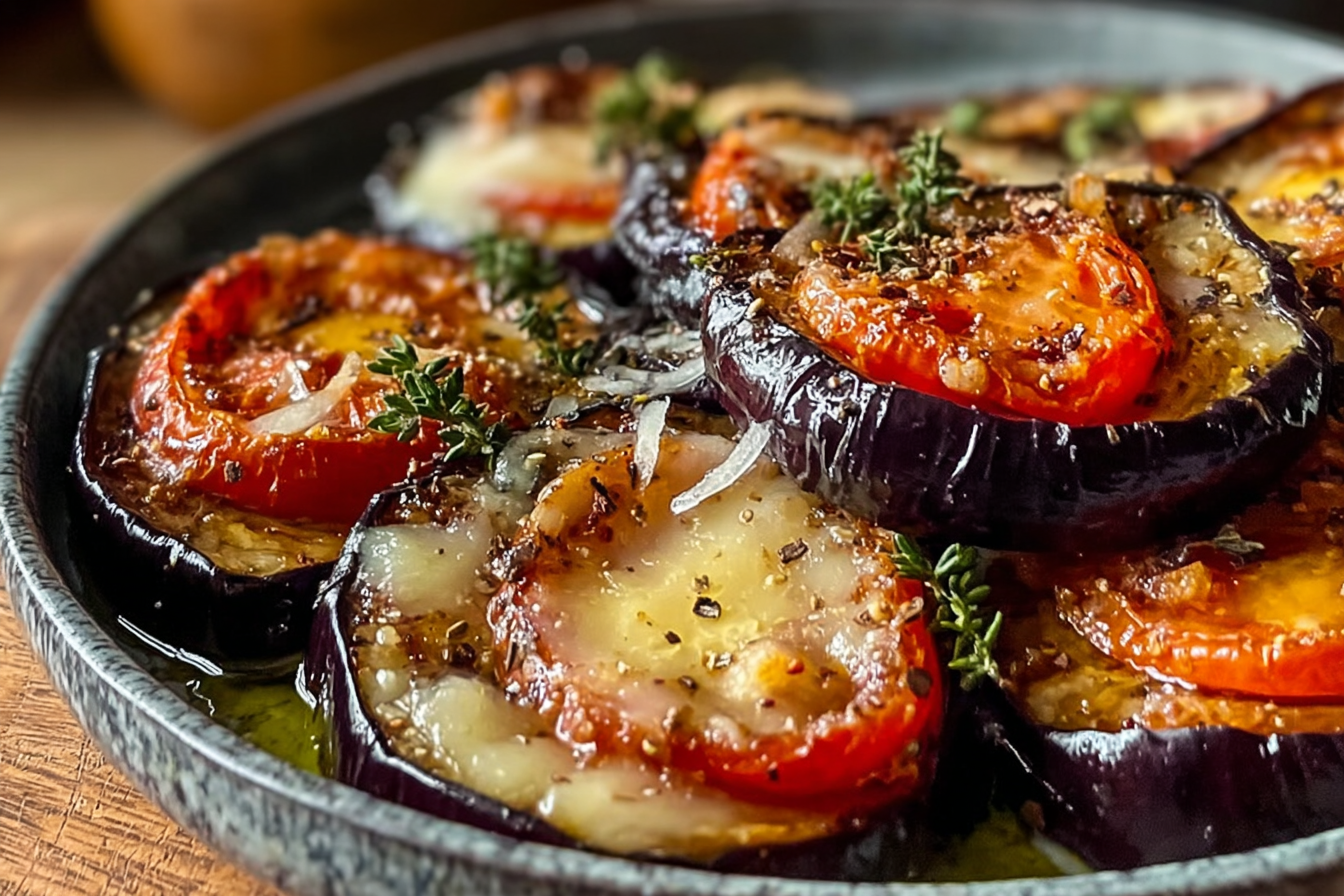Brush eggplant with oil and unlock the golden, crispy texture that makes every bite a flavor explosion. Whether you’re roasting, frying, or grilling, this simple technique transforms a bland vegetable into a rich, satisfying dish. At CookingFlash, our journey started in a small kitchen with a love for experimenting with wholesome ingredients. Our About Page shares how this passion turned into a trusted hub for everyday cooks looking to make extraordinary meals.
From Indian spice blends to Mediterranean marinades, one method reigns supreme in every style: brushing eggplant with oil before cooking. This article dives deep into why oil brushing works, the best oils to use, how to fry eggplant with flour, roast it to perfection, and even how to master eggplant on the stove. And yes, you’ll find out if avocado oil makes the cut. Let’s get sizzling!
Looking for inspiration? Try our delicious Southern Grape Salad Recipe – a sweet, creamy contrast to savory eggplant dishes!
Table of Contents
Table of Contents
Why You Should Brush Eggplant with Oil Every Time
How Oil Enhances Texture and Flavor of Eggplant
Eggplant is like a sponge—it soaks up whatever flavors and liquids you give it. That’s why brushing it with oil is more than just a step; it’s a game-changer. When you brush eggplant with oil, especially olive oil, the moisture locks in, allowing the flesh to caramelize and brown instead of drying out or turning rubbery.
Even a thin coat of oil improves flavor dramatically. Olive oil adds earthiness, while avocado oil lends a buttery depth. Grapeseed oil? That one lets the eggplant’s natural flavors shine. By brushing instead of soaking or drizzling, you control the amount, avoiding oil-logged, soggy slices.
When readers search “brush eggplant with oil people also ask recipes,” this is the golden answer: brushing allows seasonings to stick better, ensures even cooking, and prevents the dreaded mushy texture.
Avoiding Sogginess: The Secret Is Oil Brushing, Not Soaking
A mistake many cooks make is pouring oil over eggplant or marinating it too long. That results in greasy, soft slices that fall apart. Brushing, on the other hand, ensures even distribution and uses just enough to give crisp edges and golden surfaces.
Here’s why that works: when you brush eggplant with oil before roasting, you create a barrier that helps the inside stay soft while the outside crisps up. It’s like roasting potatoes—the oil adds flavor and color, not just moisture.
Plus, when prepping for dishes like roasted eggplant slices, a quick brush-and-bake technique delivers better texture and color. Whether you’re going for roasted eggplant Parmesan or a standalone veggie side, oil brushing makes all the difference.
Check out our creamy Loaded Ranch Dip Recipe for the perfect pairing with crispy eggplant fries.
Best Oils to Use When You Brush Eggplant with Oil
Comparing Olive Oil, Avocado Oil, and Grapeseed Oil
Not all oils are created equal when it comes to brushing eggplant. Each oil offers different flavor profiles, smoke points, and cooking effects. Here’s a quick comparison to help you choose:
| Oil Type | Flavor Profile | Smoke Point | Best For |
|---|---|---|---|
| Olive Oil | Earthy, rich, slightly bitter | ~375°F | Roasting, Mediterranean recipes |
| Avocado Oil | Buttery, mild, neutral | ~520°F | High-heat frying, Indian-style dishes |
| Grapeseed Oil | Light, neutral | ~420°F | Delicate dishes, quick pan-fries |
When you brush eggplant with oil, using olive oil adds depth and a signature Mediterranean touch. It pairs beautifully with garlic, rosemary, or even a balsamic glaze. For high-heat cooking or grilling, though, avocado oil wins hands down.
Even when exploring brush eggplant with oil people also ask Indian, avocado oil works well. Indian eggplant dishes like baingan bharta involve high-heat roasting or open-flame grilling, and avocado oil handles that without burning or smoking.
Grapeseed oil is ideal if you want the eggplant to soak up spices without adding extra flavor. This is especially helpful when you’re working with layered spice blends.
Don’t miss our Spinach Dip Recipe to complement your eggplant platter – perfect for any party!
Can I Fry Eggplant in Avocado Oil? Pros and Tips
Yes, you absolutely can fry eggplant in avocado oil. In fact, it might just be the best-kept secret for crispy, non-greasy fried eggplant. Thanks to its high smoke point, avocado oil can reach optimal frying temperature without breaking down, unlike many seed oils.
Here’s how to do it right:
- Slice eggplant into ½ inch circles or sticks.
- Lightly salt them to remove moisture (let sit 15 minutes, then blot).
- Dip slices in flour or seasoned breadcrumbs.
- Brush eggplant with oil – not soak – and pan fry over medium-high heat.
This technique gives you a crispy exterior and a soft, creamy center. When frying eggplant with flour, brushing with avocado oil ensures that each piece cooks evenly without soaking up excess fat.
Also, brushing instead of deep frying makes the dish healthier. You get the texture and crunch of classic fried eggplant with a fraction of the oil content.
The Science Behind Brushing Eggplant with Oil
Why Eggplant Soaks Up Oil Like a Sponge
Eggplant is unlike most vegetables—it’s filled with tiny air pockets that act like little oil traps. When raw, it’s extremely absorbent, which is why just pouring oil over it can leave you with soggy, greasy slices. That’s exactly where brushing eggplant with oil makes all the difference.
By using a brush instead of drizzling, you give each slice just enough oil to coat the surface evenly without letting it soak in too much. The result? You get a beautiful, golden crust while the inside stays tender—not mushy or oily.
This is especially important when you’re prepping dishes like roasted eggplant slices or trying to achieve that perfect base layer for roasted eggplant Parmesan. And if you’ve ever wondered how to roast whole eggplant in the oven without it drying out or turning rubbery, brushing oil on the skin before roasting is the trick you’ve been missing.
The method works across the board—from Indian baingan dishes to classic Mediterranean flavors. In fact, when brushing eggplant with oil for Indian recipes, you’ll find the spices cling better, helping you build those bold, roasted flavors layer by layer.
How Brushed Oil Helps Eggplant Brown Beautifully
There’s a reason chefs always roast veggies with oil—it kicks off the Maillard reaction, which is a fancy name for browning and caramelizing. When you brush eggplant with oil, the surface heats faster and evenly, letting sugars in the eggplant caramelize into that rich, golden color.
Without oil, eggplant tends to steam in its own moisture and ends up pale and limp. With oil brushing, it roasts, crisps, and browns beautifully. It’s the secret to why roasted eggplant slices have that irresistible flavor and texture that keep you going back for more.
This is also a major reason people search for how to cook eggplant on stove. Pan-cooked eggplant benefits from the same oil-brushing technique. A quick coat allows for faster searing and browning without the need to deep-fry or drench the pan in oil.
What you’re left with is a dish that’s lightly crispy outside, buttery soft inside—and full of that sweet-savory roasted taste that only properly oiled eggplant can deliver.
Roasting, Frying, and Grilling: Which Cooking Method Is Best for Eggplant?
Roasted Eggplant Slices vs. Grilled Eggplant: The Texture Battle
When comparing cooking methods for eggplant, roasting and grilling often go head-to-head. Both offer rich, savory flavors—but the outcome changes drastically depending on how you brush eggplant with oil before applying heat.
Roasted eggplant slices are incredibly popular because of how the oven caramelizes the outer surface. Brushing with olive oil before roasting ensures a crisp, golden crust while locking in that creamy texture inside. This method also pairs perfectly with garlic powder, black pepper, and other seasoning blends. It’s a go-to if you’re making roasted eggplant Parmesan or layering it in a hearty veggie lasagna.
On the other hand, grilled eggplant gives you a slight smokiness. It’s great for summer cookouts or if you’re aiming for a rustic presentation. Still, the key is the oil: without it, the eggplant sticks and dries out. A light brush of oil before it hits the grill ensures those nice char lines and prevents burning.
This balance is what people are really after when they search “brush eggplant with oil people also ask recipes”—they want that outer crisp, but they also want it to stay juicy inside.
How to Fry Eggplant with Flour Without It Turning Mushy
Frying eggplant might seem simple, but it’s where many go wrong. The trick to success? Don’t skip brushing.
First, slice your eggplant and lightly salt it to pull out moisture—this is key. Let it rest for about 15 minutes, then pat it dry. Dip the slices in flour, or for more crunch, a seasoned breadcrumb mix. Now here’s the magic move: brush eggplant with oil before frying in a hot skillet.
This step does two things:
- It jumpstarts the browning process.
- It limits oil absorption during frying, keeping the texture light instead of soggy.
You can fry in a shallow pan with a small amount of oil, or better yet, use avocado oil, which handles high heat beautifully. People often ask, “Can I fry eggplant in avocado oil?” Yes—you can, and it’s one of the healthiest, tastiest ways to do it.
And let’s not forget those trending questions like “how to fry eggplant with flour”—the answer lies in brushing first. Without it, you risk flour clumping or burning before the eggplant is even cooked through.
Print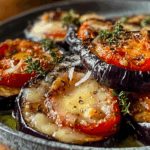
Powerful Trick to Brush Eggplant with Oil for Crispy, Golden Results
- Prep Time: 10 minutes
- Cook Time: 35 minutes
- Total Time: 45 minutes
- Yield: 4 servings
- Category: Side Dish
- Method: Roasting
- Cuisine: Mediterranean
- Diet: Vegan
Description
These oven-roasted eggplant slices are a simple, healthy, and flavorful side dish. Perfectly seasoned and caramelized to golden perfection, they’re a great addition to any meal!
Ingredients
- 2 medium eggplants (~1 lb each)
- 1/4 cup olive oil
- 1/2 tsp sea salt
- 1/2 tsp garlic powder
- 1/4 tsp black pepper
Instructions
- Preheat the oven to 400°F (204°C).
- Slice the eggplants crosswise into 1/2 inch (1.25 cm) thick rounds. Remove the leafy end after slicing.
- Arrange the eggplant slices on a large baking sheet in a single layer.
- Brush each slice with olive oil and sprinkle with sea salt, garlic powder, and black pepper.
- Flip each slice and repeat the seasoning and oil on the other side.
- Roast in the oven for 30–35 minutes, until soft, golden, and caramelized. Flip halfway through if desired.
Notes
- No need to peel the eggplant; the skin helps hold the slices together while roasting.
- Use parchment paper for easier cleanup.
- Add fresh herbs or Parmesan cheese after roasting for extra flavor.
Nutrition
- Serving Size: 1/4 of recipe
- Calories: 110
- Sugar: 3g
- Sodium: 300mg
- Fat: 10g
- Saturated Fat: 1.5g
- Unsaturated Fat: 8.5g
- Trans Fat: 0g
- Carbohydrates: 6g
- Fiber: 3g
- Protein: 1g
- Cholesterol: 0mg
Step-by-Step Recipe to Roast Eggplant Slices FOR Brush eggplant with oil
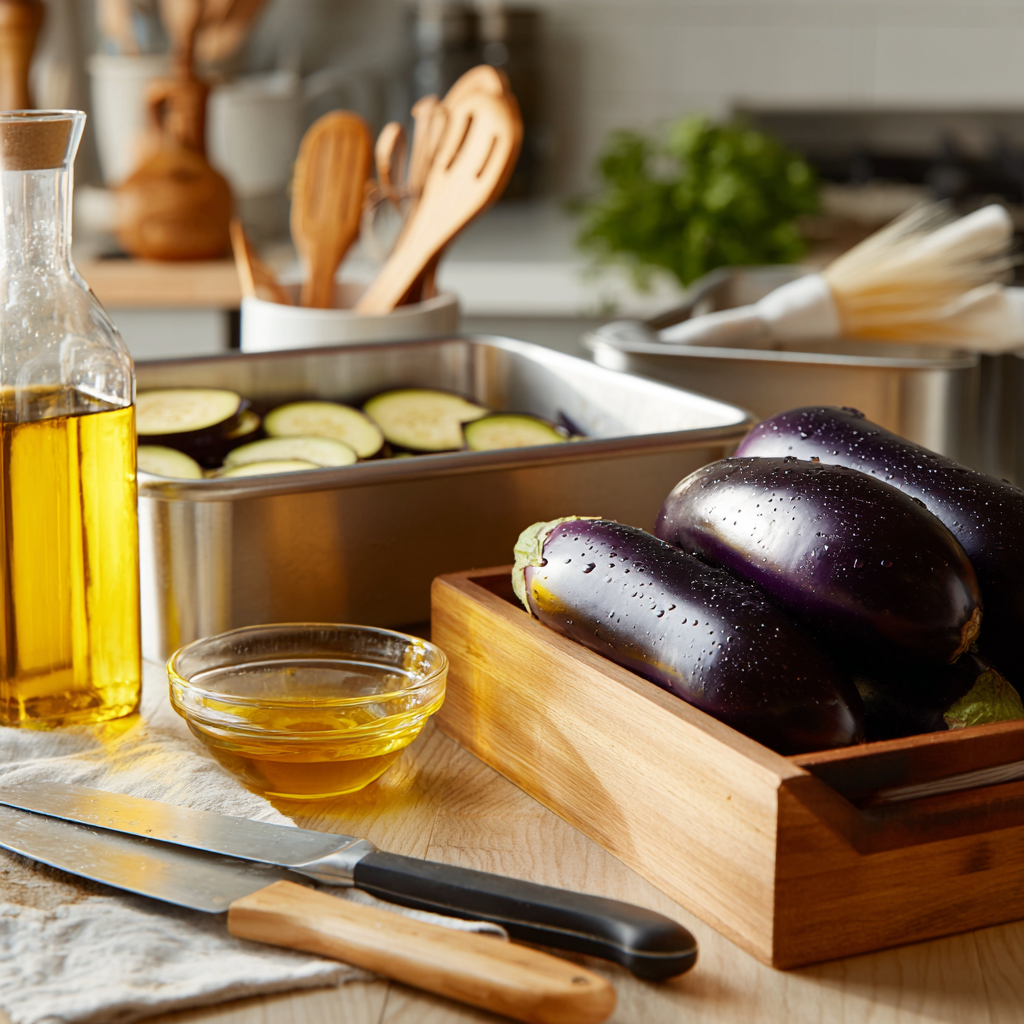
Ingredients You’ll Need FOR Brush eggplant with oil
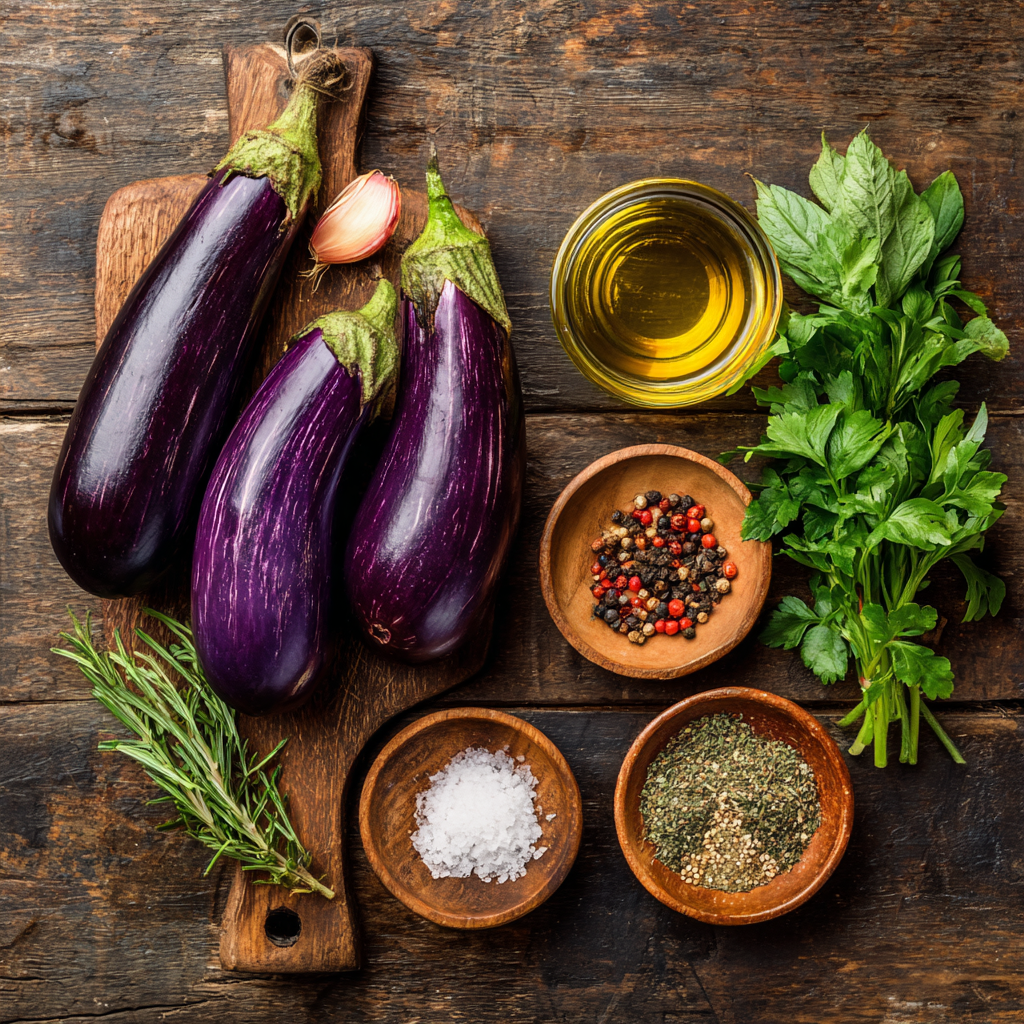
To make the most flavorful and perfectly textured roasted eggplant, you only need a few pantry staples:
- 2 medium eggplants (about 1 lb each)
- ¼ cup olive oil
- ½ tsp sea salt
- ½ tsp garlic powder
- ¼ tsp black pepper
This basic blend brings out the natural flavor of the eggplant while enhancing the crisp finish you get when you brush eggplant with oil before roasting. You can also experiment with cumin, smoked paprika, or Italian herbs for a regional twist.
Prep Tips: Slice, Season, and Brush Like a Pro
Start by preheating your oven to 400°F (204°C)—this is the sweet spot for golden edges and a tender inside.
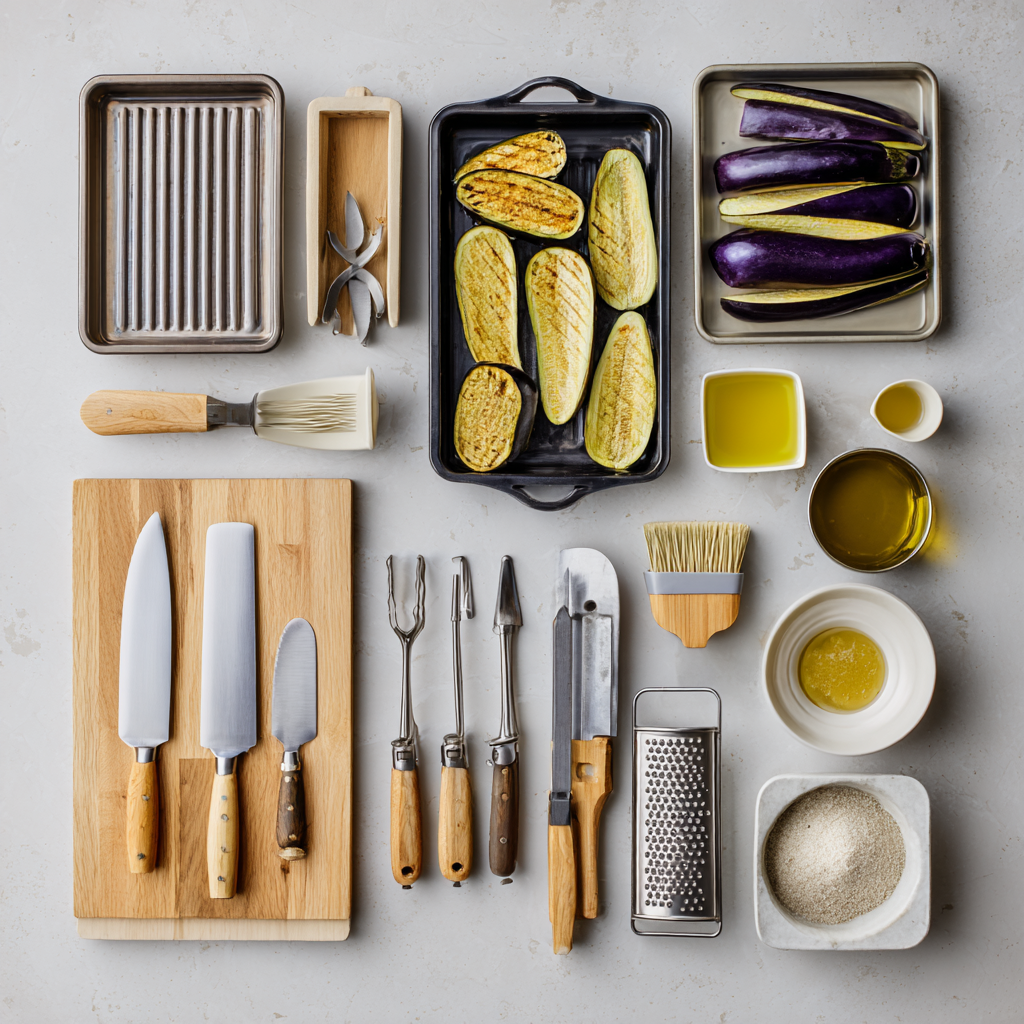
Step 1: Slice the eggplant into circles. FOR Brush eggplant with oil
Cut each eggplant crosswise into ½-inch rounds. Don’t cut off the leafy top right away—holding it gives you better grip and cleaner cuts.
Step 2: Lay them out in a single layer FOR Brush eggplant with oil.
Use a large baking sheet and space the slices out. Overcrowding causes steam and ruins the crisp texture.
Step 3: Brush eggplant with oil generously FOR Brush eggplant with oil.
Using a pastry brush, coat the tops of each slice with olive oil. Then sprinkle with sea salt, garlic powder, and black pepper. Flip them over and repeat. This brushing technique ensures even caramelization and prevents dry, uneven roasting.
Pro Tip: If you’re making this for guests or layering into a roasted eggplant parmesan, try brushing with a garlic-infused olive oil for extra depth.
Roast It Right: Timing and Temperature FOR Brush eggplant with oil
Pop the tray in your preheated oven and roast for 30 to 35 minutes. Halfway through, you can flip the slices—but it’s optional. They’ll still come out beautifully browned and slightly caramelized on the bottom.
When they’re done, the edges should be crisp and lightly golden, while the centers stay soft and velvety. This is exactly what makes these slices so versatile—they’re perfect served as a side dish, stacked into sandwiches, or topped with mozzarella and marinara.
And yes, this method answers every version of “roasted eggplant slices” queries floating around. The key is in the brushing—without it, eggplant either dries up or turns into a mushy mess.
Indian and Mediterranean Techniques to Brush Eggplant with Oil
Brushing Eggplant with Oil in Indian Cooking: A Flavor-Building Ritual FOR Brush eggplant with oil
In Indian cuisine, eggplant isn’t just a side vegetable—it’s a showstopper. Dishes like smoky baingan bharta or stuffed eggplant curry make the most of its meaty texture. And what’s the first step most Indian home cooks won’t skip? Brushing eggplant with oil.
For baingan bharta, the eggplant is typically roasted whole over an open flame or baked in the oven. But before that, cooks coat the entire skin in oil. This not only keeps the skin from drying out and splitting too quickly—it helps soften the inside, infusing it with a natural roasted aroma. That’s what gives this dish its signature smoky taste.
And if you’ve ever searched “brush eggplant with oil people also ask Indian”, you’ve probably seen spiced stuffed eggplant pop up. In regional recipes like Maharashtrian bharli vangi or South Indian-style fry-ups, baby eggplants are filled with a blend of ground spices—coriander, cumin, turmeric, chili, and even coconut—then brushed with oil before cooking. That thin layer of oil seals the spices in and forms a beautiful crust as it cooks.
Tip to try: Mix neutral oil with mustard seeds and a dash of asafoetida (hing) before brushing on your eggplant. It adds depth and complements those bold Indian flavors beautifully.
Mediterranean-Style Eggplant: Olive Oil and Herbal Simplicity FOR Brush eggplant with oil
In Mediterranean kitchens, eggplant is all about simplicity, balance, and brightness. But the one rule that stays constant across borders? Always brush eggplant with oil before grilling, baking, or roasting.
Whether you’re roasting thick slices for melanzane alla parmigiana in Italy or grilling eggplant steaks for a mezze platter in Greece, brushing the slices with extra virgin olive oil is non-negotiable. The oil enhances the natural sweetness of eggplant and helps achieve that golden brown finish everyone loves.
Instead of heavy spices, Mediterranean cooks let fresh herbs do the talking. After brushing the eggplant, they sprinkle on oregano, thyme, or rosemary. This allows the flavors to penetrate during roasting without overpowering the dish. When grilled, that light coating of oil prevents sticking and promotes those gorgeous char marks that make eggplant irresistible.
Thinking of making roasted eggplant Parmesan the healthier way? Skip the frying, slice and brush your eggplant with olive oil, roast until golden, then layer it with marinara and fresh mozzarella. It’s lighter, less greasy, and just as indulgent.
How to Cook Eggplant on Stove Without Excess Oil
Dry Searing Meets Oil Brushing: A Game-Changer for Pan Cooking FOR Brush eggplant with oil
Cooking eggplant on the stove doesn’t have to mean soaking it in oil. In fact, it’s possible to get beautifully browned slices with less fat—if you brush eggplant with oil first.
Unlike deep-frying, pan-searing gives you more control over the final texture. To make it work, heat a nonstick or cast-iron skillet over medium-high heat. While the pan warms up, brush both sides of your eggplant slices with olive oil. Just a light layer is enough—no need to drench it.
Brushing before cooking does two important things:
- It helps the eggplant brown evenly without sticking.
- It cuts down on how much oil you need in the pan.
Once the pan is hot, add the slices in a single layer and let them cook for 3–4 minutes per side. You’ll notice how quickly they start to sizzle and caramelize—thanks to that even oil coating.
If you searched “how to cook eggplant on stove”, this is exactly the kind of clean, efficient method most people are looking for. It’s quicker than roasting and cleaner than frying, yet the results are still deliciously crisp on the outside and soft inside.
Stovetop Stir-Fry and Skillet Meals with Brushed Eggplant
Looking for a faster weeknight option? Try a stir-fry. Start by slicing your eggplant into thin strips or cubes and brush them lightly with oil. Add them to a hot skillet with garlic, onions, and your choice of veggies. Because the eggplant is pre-oiled, it cooks more evenly and doesn’t require you to keep adding fat as it sautés.
This approach is perfect for Asian-inspired dishes with soy sauce and sesame oil or for Mediterranean skillet meals with cherry tomatoes and basil. It also works great with Indian spice mixes, especially if you’re aiming for bold flavor in a short cook time.
And if you’re wondering how this stacks up against roasting or grilling—brushing is the common denominator. No matter the method, the simple act of brushing eggplant with oil before cooking keeps it from drying out, helps it brown properly, and carries flavor directly into the flesh.
What Fried Eggplant Really Tastes Like and How Oil Brushing Makes It Better
Fried Eggplant’s Signature Taste: Crispy Edges, Silky Center
When fried correctly, eggplant transforms into a dish that’s crispy outside with a rich, velvety interior. Its flavor is mild, slightly sweet, and incredibly adaptable—it can take on bold spices or stand on its own with just a sprinkle of salt and pepper.
But the real secret to achieving this golden texture? You guessed it—brush eggplant with oil before frying.
Eggplant naturally absorbs oil like a sponge, and without proper preparation, it can become overly greasy and heavy. By brushing instead of soaking, you create a thin, even layer that helps the surface brown and crisp up while keeping the inside creamy and tender. This method works especially well when frying slices that are coated in flour or breadcrumbs.
If you’re curious about what fried eggplant tastes like, imagine a buttery-soft bite with a crispy shell—almost like a vegetable version of mozzarella sticks, but lighter and healthier (depending on how much oil you use, of course).
A few well-placed herbs like fresh basil or a sprinkle of Parmesan on top, and you’ve got a fried eggplant side that’s both elegant and comforting.
The Role of Oil in Eggplant Recipes: Flavor, Texture, and Cooking Power
There’s often confusion around the phrase “eggplant oil”—but in most home kitchens, it simply refers to the oils used during cooking to flavor or prepare eggplant. Whether you’re pan-frying, roasting, or grilling, the type of oil you choose will impact both the taste and texture of the final dish.
So what is eggplant oil used for? It’s all about enhancing:
- Flavor: Extra virgin olive oil brings an earthy, slightly peppery note that’s perfect for Mediterranean-style eggplant.
- Moisture retention: Brushing oil helps prevent the eggplant from drying out during cooking.
- Heat conduction: Oils like avocado and grapeseed support high-heat frying or roasting without smoking or breaking down.
That’s why when you brush eggplant with oil, you’re not just adding fat—you’re adding character to your dish.
And when frying eggplant with a light flour coating, brushing it first helps that flour adhere properly and crisp in the pan instead of becoming gummy or falling off. This is the insider trick behind many professional kitchens when preparing eggplant fries or cutlets.
If you’re exploring terms like “how to fry eggplant with flour”, this step is essential for getting the crispy finish without the soggy mess. Use a pastry brush to coat the slices evenly, then apply your breading or flour. Fry just until golden, and you’ll be amazed by how much better the texture turns out.
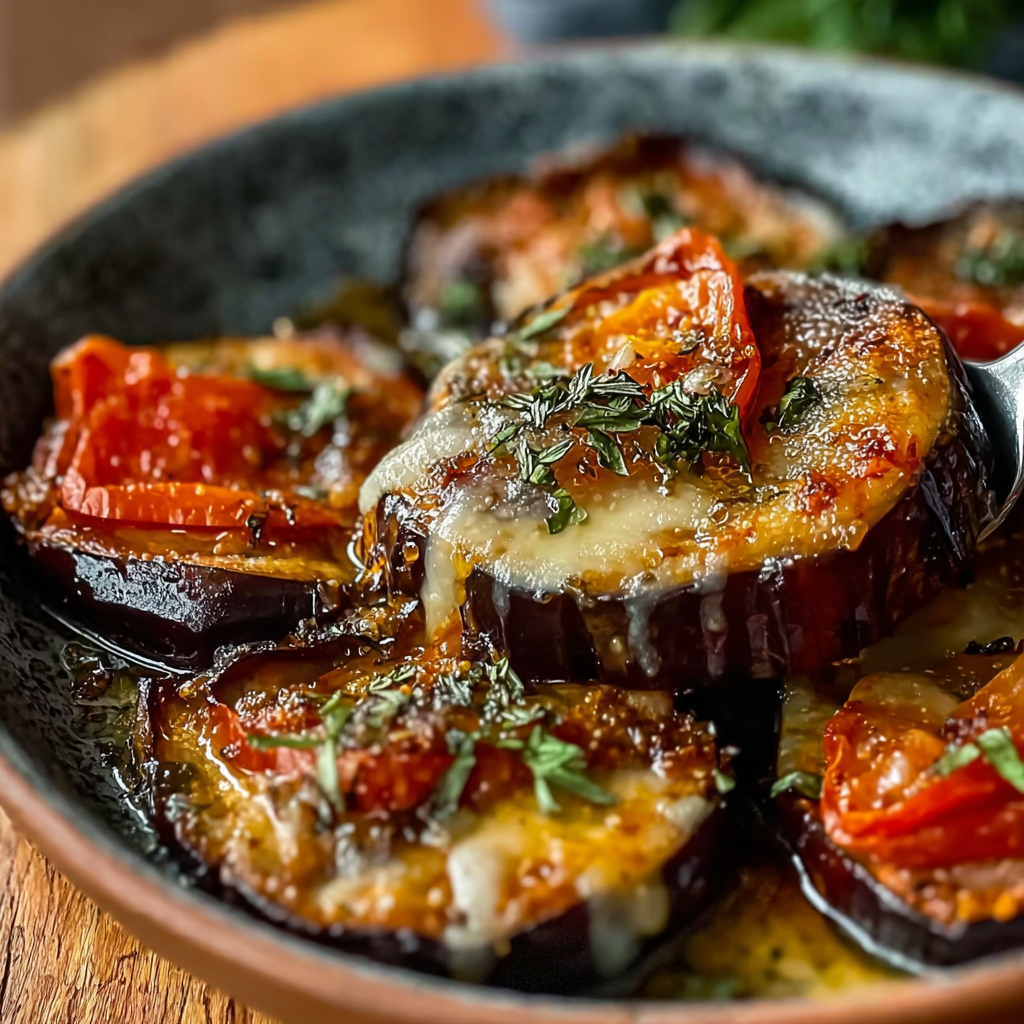
Common Mistakes When Brushing Eggplant with Oil
Using Too Much or Too Little Oil: Finding the Sweet Spot
One of the biggest mistakes home cooks make when working with eggplant is overdoing the oil—or not using enough at all. Eggplant is naturally absorbent, and if you pour oil directly on it, it will soak it up like a sponge. The result? Greasy, limp slices that feel heavy instead of crisp.
On the flip side, skipping oil entirely or using just a drop won’t get you the browning you’re after. That’s why the most effective technique is to brush eggplant with oil using a pastry brush or silicone basting brush. This method gives you complete control, ensuring each slice is coated evenly but not drenched.
A thin, even layer is all you need to support caramelization during roasting or create a barrier for frying. It also helps seasonings stick better, enhancing the overall taste.
Pro tip: For roasted eggplant slices or roasted eggplant Parmesan, brush both sides lightly before baking. If you’re grilling, brush just one side to prevent flare-ups.
Skipping the Salt Step or Rushing the Prep
Another overlooked step? Pre-salting your eggplant. Salting slices before brushing with oil pulls out excess moisture, which keeps the texture firm and prevents sogginess. Let your slices sit with a sprinkle of salt for 15 to 20 minutes, then blot with a paper towel before brushing on the oil.
Skipping this step means your eggplant could release water during cooking, causing steam instead of sear. You’ll also miss out on that creamy, rich interior everyone loves.
If you’ve searched “brush eggplant with oil people also ask recipes” or “how to roast whole eggplant in oven”, many top methods recommend salting first, then oiling. That order matters more than you might think.
Here’s a quick mistake-repair checklist:
| Mistake | Fix |
|---|---|
| Pouring oil instead of brushing | Use a brush for even, controlled coverage |
| Skipping the salt step | Salt and rest slices 15 mins before oil |
| Using cold eggplant | Let slices come to room temp for better searing |
| Overcrowding on the pan or tray | Give slices space to roast or fry evenly |
Avoiding these missteps helps you unlock the full potential of any eggplant dish—whether you’re frying, roasting, or cooking on the stovetop.
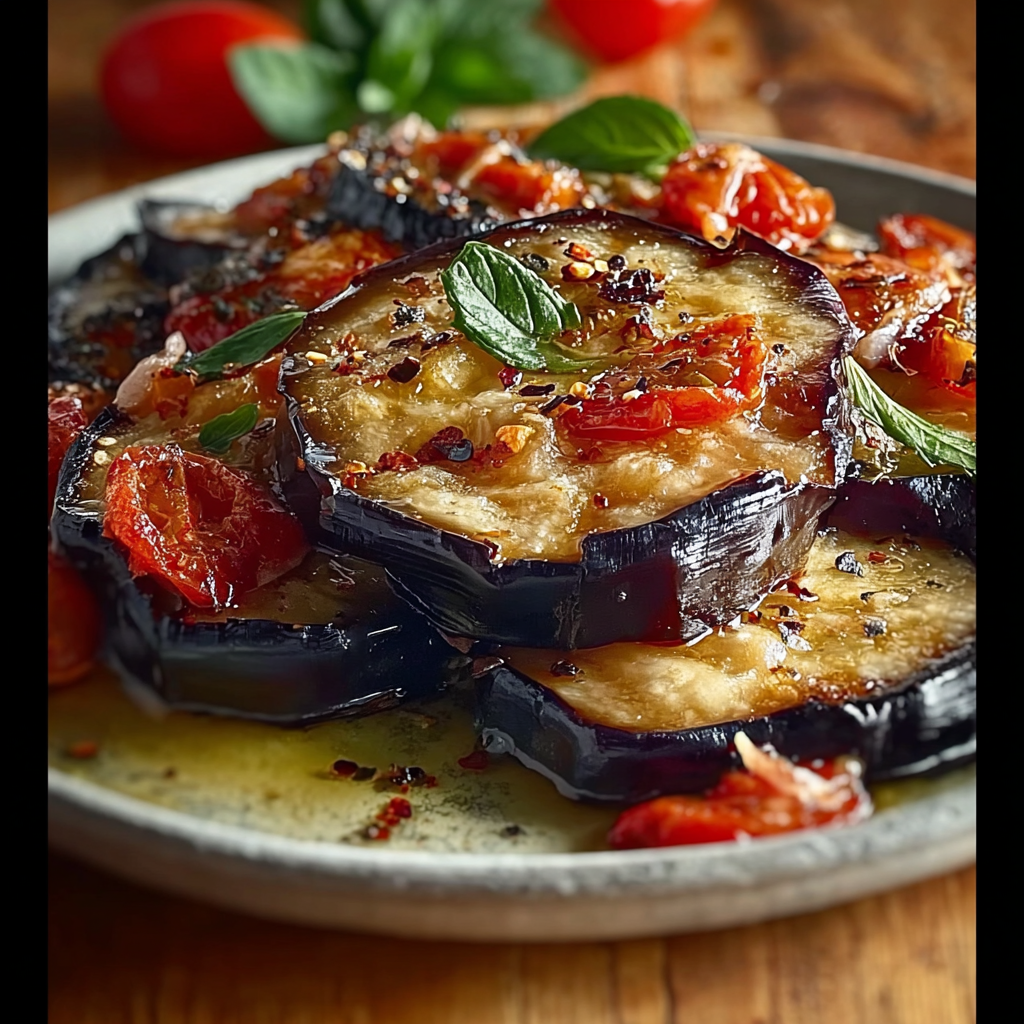
Why Brushing Eggplant with Oil Is the Ultimate Kitchen Upgrade
At the heart of every perfectly cooked eggplant dish is one simple yet powerful step: brush eggplant with oil. It’s the kind of technique that transforms your results from average to extraordinary—bringing out a crisp, golden exterior and preserving the creamy texture inside.
Throughout this guide, you’ve discovered how oil brushing enhances everything from roasted eggplant slices to Indian-style stuffed eggplant and Mediterranean-inspired meals. Whether you’re using olive oil for richness or avocado oil for high-heat frying, brushing—not pouring—ensures even coverage, prevents sogginess, and locks in flavor.
More than just a tip, brushing eggplant with oil is a gateway to better texture, better taste, and better results—no matter your cooking method. It’s a quick habit that delivers big rewards, and once you’ve done it, you’ll never skip it again.
So the next time you prep eggplant—remember: don’t drench it, brush it. It’s a small move that makes a huge difference.Tray this : Firecracker Chicken
How to fry eggplant with flour?
First, slice and salt your eggplant, then pat it dry. Lightly brush the eggplant with oil, coat each slice in flour, and pan-fry in a hot skillet until golden brown. Brushing before flouring helps the coating stick and cook evenly without absorbing too much oil.
How to roast whole eggplant in oven?
To roast a whole eggplant, preheat your oven to 400°F. Prick the skin with a fork, brush the eggplant with oil, and roast on a baking sheet for 35–45 minutes. It’s ready when the skin is shriveled and the inside is soft. Perfect for dips like baba ganoush or mashing into flavorful spreads.
Does eggplant need oil to cook?
Technically, eggplant can cook without oil, but it won’t taste or look as good. Eggplant is highly absorbent and prone to drying out. Brushing eggplant with oil ensures that it cooks evenly, browns properly, and doesn’t turn rubbery or bland. Even when baking or pan-searing, a light brush makes a big difference.
What does fried eggplant taste like?
Roasting is widely considered the best method for eggplant. When you brush eggplant with oil before roasting, it develops crisp edges and a rich, soft center. Grilling adds a smoky flavor, while stovetop searing gives a quick, caramelized surface. The method you choose should depend on the texture and flavor profile you want—but oil brushing makes them all better.

